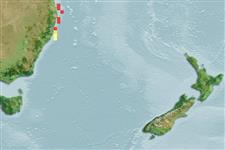ກຸ່ມປາກະດູກອ່ອນ (ເຊັ່ນ: ປາສະຫລາມ, ປາຜາໄລ) (sharks and rays) >
Rajiformes (Skates and rays) >
Arhynchobatidae (Softnose skates)
Etymology: Pavoraja: Latin, pavo = peacock + Latin, raja, -ae = a sting ray (Raja sp.) (Ref. 45335); umbrosa: Name from Latin 'umbrosus' for shady, refers to the uniform greyish dorsal surface of the disc.
More on authors: Last, Mallick & Yearsley.
Environment: milieu / climate zone / ລະດັບຄວາມເລິກ / distribution range
ນິເວດວິທະຍາ
ສັດທະເລ ກ່ຽວກັບ(ຢູ່)ຊັ້ນນ້ຳໃນທະເລທີ່ເໜີອພື້ນດິນ; ລະດັບຄວາມເລິກ 360 - 731 m (Ref. 76878). Tropical; 27°S - 33°S, 153°E - 156°E (Ref. 114953)
Western Pacific: off New South Wales, eastern Australia.
Length at first maturity / ຂະໜາດ / ນ້ຳໜັກ / Age
ການຈະເລີນເຕັມໄວ: Lm ?, range 35 - ? cm
Max length : 36.9 cm TL ຕົວຜູ້/ບໍ່ມີເພດ; (Ref. 76878)
A demersal species found on upper continental slope. Males reaches maturity at ca. 32-35 cm TL, smallest juvenile 8cm TL. Discarded bycatch of local trawl fisheries (Ref. 114953)
Life cycle and mating behavior
ການຈະເລີນເຕັມໄວ | ການສືບພັນ | ການວາງໄຂ່ | ໄຂ່ | ຄວາມດົກຂອງໄຂ່ປາ | ຕົວອ່ອນ
Last, P.R., S. Mallick and G.K. Yearsley, 2008. A review of the Australian skate genus Pavoraja Whitley (Rajiformes: Arhynchobatidae). Zootaxa 1812:1-45. (Ref. 76878)
IUCN Red List Status (Ref. 130435: Version 2025-1)
Threat to humans
Harmless
Human uses
ການປະມົງ: bycatch
ເຄື່ອງມື
Special reports
Download XML
ແຫຼ່ງອີນເຕີເນັດ
Estimates based on models
Preferred temperature (ເອກະສານອ້າງອີງ
123201): 6.8 - 12.6, mean 8.3 °C (based on 51 cells).
Phylogenetic diversity index (ເອກະສານອ້າງອີງ
82804): PD
50 = 0.5156 [Uniqueness, from 0.5 = low to 2.0 = high].
Bayesian length-weight: a=0.00562 (0.00288 - 0.01097), b=3.11 (2.94 - 3.28), in cm total length, based on LWR estimates for this (Sub)family-body shape (Ref.
93245).
ຊັ້ນເຂດຮ້ອນ (ເອກະສານອ້າງອີງ
69278): 3.7 ±0.7 se; based on size and trophs of closest relatives
ຄວາມຢືດຢຸ່ນ (ເອກະສານອ້າງອີງ
120179): ຕຳ່, ປະຊາກອນຕຳ່ສຸດທີ່ໃຊ້ເວລາສອງເທົ່າ 4.5 - 14 ປີ (Preliminary low fecundity).
Fishing Vulnerability (Ref.
59153): Low to moderate vulnerability (27 of 100).
🛈
